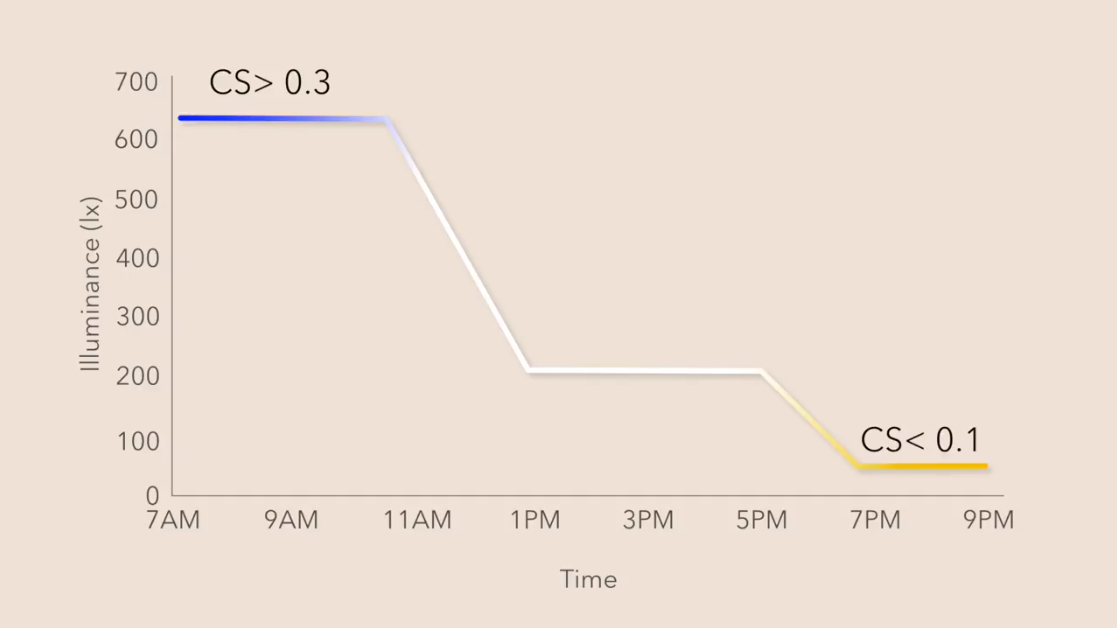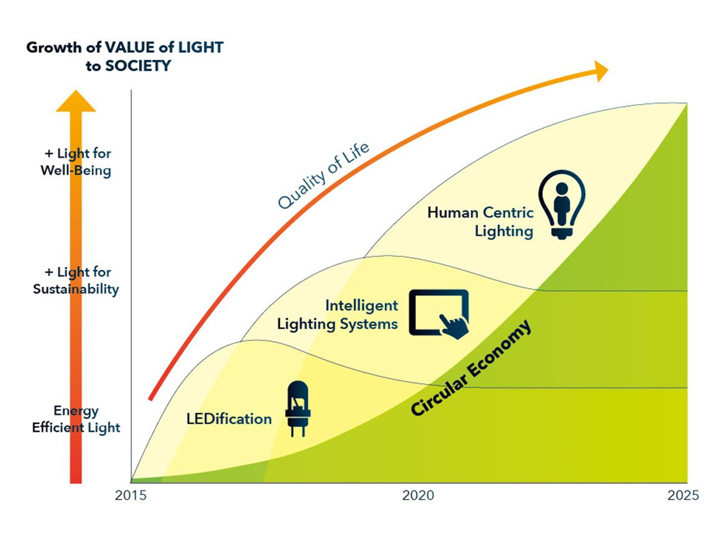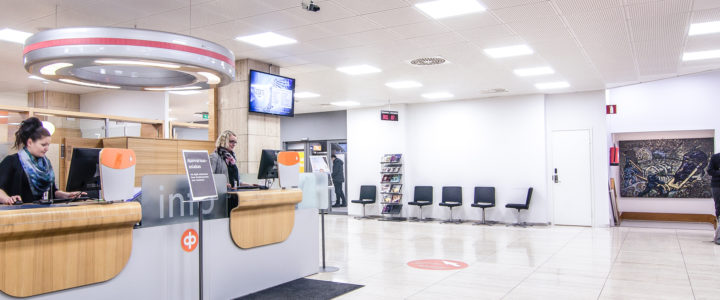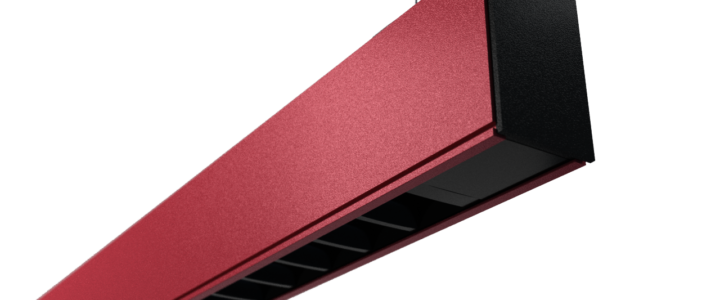Talk to our lighting experts  +358 20 125 5800
+358 20 125 5800

September 26, 2018
Human Centric Lighting: Now, Then and Tomorrow
Throughout history, people have lived in sync with the Earth’s lighting cycle. At mid-day, we’re exposed to high light levels and high correlated color temperatures (CCTs), whereas at night the light levels are extremely low. The shift in light levels happens gradually, letting our bodies adapt and adjust to the change.
That is if we’re outside.
However, while our ancestors spent about 90 % of their waking time outside, we spend 90 % of it indoors. We wake up in our poorly lit apartments, jump into our cars and spend our days indoors, often in poorly lit offices or dim classrooms.
To make things worse, we spend an ever-increasing portion of our spare time in the evenings exposed to blue-rich light, staring at the screens of our mobile phones or tablets.
The influence that light has on our bodies reaches far beyond the visual effects. In fact, the varying light levels are at the heart of a human’s internal clock, also known as the circadian rhythm. Light and darkness control our hormone production, thus influencing our sleep, alertness, mood, memory and performance.
It is only recently that we have come to realise the potential of lighting in synchronizing our body clock. If we could control the lighting in our buildings better, we could create solutions that support our well-being.
No wonder the whole lighting world is buzzing over the concept of Human Centric Lighting also referred to as Circadian Lighting.
The biology behind it
We all know light has a big impact on our vision. Simply put, we see much better in a well-lit environment and stumble in the dark. However, scientists have only recently started to understand the non-visual, physiological effects that light has on us.
An important discovery affecting the birth of circadian lighting was originally made by a team at Oxford University, led by Neuroscientist Russell Foster. What they discovered were the intrinsically photosensitive retinal ganglion cells (ipRGC), affecting the part of our brain that generates and regulates our internal clock.
What is so special about these cells, you might be wondering.
These cells, key to controlling our body clock, are especially responsive to light that is rich in blue content. Moreover, blue light content suppresses melatonin, a hormone related to sleep.
But what does that mean to you? While we need melatonin to sleep, getting these blue light signals at the wrong time could lead to circadian misalignment. On the other hand, greater exposure to blueish, bright light during the day could help people be more alert and productive at work.

Kuva: The Lighting Research Center recommends getting high Circadian stimulus in the morning, at least 0.3 with bright, blueish white light and low CS in the evening, no more than 0.1 with dim, yellowish white light. (Source: The LRC Light and health video series, part #2)
Technology – the enabler
Has something changed now, or why are people suddenly so interested in human centric lighting? The truth is that it is only in recent years that we have had the technology to develop human centric lighting concepts.
LED lighting as a technology opens up many possibilities that weren’t always there. With the ability to tune the spectrum and the level of lighting, LEDs provide an outstanding starting point for human centric lighting.
In fact, human centric lighting should be tunable, not just dimmable. Hardware and software combined, lighting manufacturers can now provide solutions that allow you to adjust and program light intensity and change spectrum.
The benefits of Human Centric Lighting (HCL)
While natural light is dynamic from sunrise to sunset, the electronic lighting in most of our properties is fixed from morning to evening. Apart from night shift workers, the people most likely to have out-of-sync circadian rhythms are those that spend a lot of time indoors exposed to dim lights, such as office workers, nursing home patients or students.
As we’ve slowly come to understand the non-visual effects of light, researchers around the globe have directed their interest towards these groups of people. Here’s a list of benefits that studies around the world have reported with examining the HCL concepts:
- Increased accuracy, productivity, better sleep and lower levels of depression and stress among office workers1
- Improved oral reading fluency performance, increased alertness and higher test scores among students 2
- Higher productivity and fewer errors, accidents and absence in repetitive industrial tasks3
- Improvement of vitality, orientation, emotional stability, sleep quality and symptoms of dementia among the elderly4
- Improved alertness and performance with night shift workers5
Beyond the benefits at the individual level, improved lighting conditions bring value to business owners, investors and societies. These benefits include labour cost savings, productivity increases and public cost savings.
In a 2015 study by A.T. Kearney, LightingEurope and ZVEI3, the macro-level simulations yielded Human Centric Lighting effects for Europe of up to € 12.8 billion if the 2020 lighting market was fully penetrated by Human Centric Lighting.

Image: The Strategic Roadmap 2025 of LightingEurope was published in March 2016. It demonstrates the increasing growth in the value of light to society. Over recent decades, a lot of effort has gone into reducing the energy consumed by lighting. New system capabilities will adapt lighting conditions to suit the user thus creating high value to society.
Are we ready for it?
Over the past few years, lighting manufacturers have been quick to commercialise human centric lighting concepts. The technology now enables human centric lighting concepts, but some have started to question whether we’re really ready for it. In 2018, the world authority on the subject even declared that it’s too early to implement human centric lighting.
Why the doubt?
It’s fair to say that the concept of human centric lighting is much more complicated than “blue light good, red light bad”. While there are many field studies on human centric lighting, we all know that every individual is different. On that note, human centric lighting should not just support the activities expected in each space but support each of us individually, dynamically reacting to the changes in our alertness or hormone levels.
Right now, the human centric lighting concepts offer dimming possibilities and tunable white, but the actual applications are seldom dynamic or truly personalised. Why so?
We asked our Director of Development Vesa Vähänen, and the answer is clear:
“For customers, usability still plays a great role in the whole process. As it should. While technology advances fast, in the real-world it’s not just about the hype. Lighting needs to function reliably and it needs to be both cost-effective and easy to manage.
Many of our customers have calculated how much the productivity of their employees has increased with changing to LED technology. The numbers are big. But are these real-life success stories yet telling the story of human centric lighting? No, not yet. Instead, they tell the story of high-quality lighting, and the major effect it has on our day-to-day life.
For us, the most important thing is to make sure the lighting is trustworthy, easy to use and supports the activities and tasks people are expected to do in each space. And how to achieve that? Simply by providing a lighting solution, and no less than that – including high-quality luminaires, great design and a lighting control technology.”
What would a dynamic, truly personalised lighting require, then? The answer lies within the IoT.
“With IoT in place and an increasing portion of us carrying smartwatches and smart rings, the future of human centric lighting is full of further potential.
As a lighting manufacturer, we constantly have our hand on the pulse, collaborating with light management system providers to bring the latest within the reach of our customers.
With the help of IoT, perhaps we can all soon have a truly human-centric, individual lighting plan that would predict and dynamically react to the changes and in our bodies. Now that would be human centric lighting to the core.”
While waiting for that, one thing is for sure.
Lighting is all around us as and it is an essential service in every space. Right now, our kids, our grandparents, you and me, we spend a lot of time indoors exposed to dim lights. Knowing that high-quality lighting has a significant impact on our well-being and productivity, wouldn’t it be mad not to invest in it?
Sources:
1 T. Mak & L. Nelson, CBRE Healthy Offices Research; M. G. Figueiro et al., The impact of daytime light exposures on sleep and mood in office workers, 2017.
2 M. S. Mott et. al., Illuminating the Effects of Dynamic Lighting on Student Learning, 2012; K. Choi & H. Suk, Dynamic lighting system for the learning environment: performance of elementary students, 2016
3 A. T. Kearney (LightingEurope & ZVEI), Quantified Benefits of Human Centric Lighting, 2015
4 Riemersma et al., Effect of bright light and melatonin on cognitive and noncognitive function in elderly residents of group care facilities: a randomized controlled trial, 2008; Bieske et al., Influence of artificial daylight on gerontopsychiatric care of elderly people, 2006
5 Figueiro et al. Light at Night and Measures of Alertness and Performance: Implications for Shift Workers, 2016





